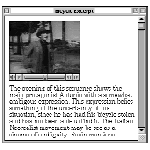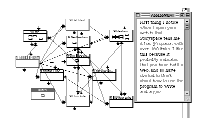Storyspace on the Big Screen
Adrian Miles
In Cinema Studies at the Royal Melbourne Institute of Technology, students take advantage of Storyspace's hypermedia capabilities to produce academic essays that are a significant departure from what has been previously possible. Their hypertexts incorporate still image, digitized video, and sound into their work, and in some cases the hypertexts are then shared and linked among groups of students. This benefits the teaching and writing of film theory in not only pedagogic contexts but for film writing in general.

Figure 1. A student Storyspace hypertext for Cinema Studies discusses de Sica's The Bicycle Thief
Because writing about the cinema has relied upon the formal written essay, it has always been extremely difficult to describe, explain, or illustrate, what aspect of a film-- or the cinema--is being discussed. This is a particular problem with students, who don't usually have access to film stills or appropriate technology to add visual content to their essays. It is also exacerbated in student work where often an essay will spend an unnecessary length of time describing a shot, or worse, a sequence, to illustrate a theoretical point. With only a few introductory classes in Storyspace, combined with a cheap video digitizing card in a low-end Macintosh computer, stills and digitized extracts of the film are able to be incorporated into their work. This reduces the students' anxiety about describing the film itself, and allows the essay to be able to concentrate very specifically on their argument--or arguments (figure 1).
In assessing student essays submitted in this format I embed my comments within their work, with links to the sections I am commenting upon (figure 2). Some students have then incorporated my work into theirs. They not only follow up my comments, but actively link to and from them--sometimes to contest, other times to acknowledge my position. On other occasions extracts from a specific critical essay have been made available as a hypertext, and a class freely links to and from this essay as they annotate and discuss the work. In turn all this additional material may even be incorporated into a single hypertext so that all students can read what other students have done, and in turn create new links within the text, and make further comments.

Figure 2. A student Storyspace hypertext where my comments are visible. These contain links to the sections of the hypertext essay that are being addressed. It is up to the student whether or not they retain or delete these observations in their final work.
A major emphasis within hypertext environments is the process of writing and construction. Unlike most multimedia production systems (which require expensive, resource-rich, and high-end programs, computers, and skills) hypertext authoring occurs in the same environment as hypertext reading. The writer literally works in a non-linear environment, in a non-linear manner. Multiple text spaces can be open at any time, multiple hypertext documents can be open, multiple views of a particular hypertext can be available, and linking can take place across any of these spaces.
In work of this sort (unlike multimedia publishing) there is no particular demand to produce texts that are the digital equivalent of "coffee table" books. A hypertext can be a small essay (such as this), a collection of interrelated works (such as an anthology), or a major project delivered via CD-ROM. They may fit on a floppy disk, be distributed via the Internet, or simply mailed to somebody. This allows hypertext writing to be pragmatically much more of the everyday. Rather than something that is used intensively, it becomes extensive.
...an exemplary writing tool that encourages associative thinking and argument
These simple examples ought to illustrate how the relationship between author and reader, and between reader and text, is actively opened and enlarged by hypertext. It is within this space that the full implications of a new digital reading and writing practice are being developed, and it is this space that constitutes the possibilities for a new form of academic engagement. By allowing the object of study to be incorporated into their work, students not only reduce the distance between their essays and their object, but are encouraged to develop readings, analyses, and ideas around their key thesis. This is because Storyspace is not only a hypertext reading environment (like HTML and the World Wide Web) but is an exemplary writing tool that encourages associative thinking and argument to become a part of the hypertext. This non-linear writing (as opposed to the simpler non-linear reading) encourages and allows multiple contexts to remain in their work, as unlike the traditional written essay, hypertext does not need to place the same premium on rhetorical cohesion around a single major argument.
...a new paradigm for writing about the cinema
The combination of film stills and digitized video, with non-linear writing and its multiple arguments and contexts, allows hypertext to provide academic cinema studies with what might be a new paradigm for writing about the cinema. It is certainly providing students with not only a method of addressing cinema, but appears to be assisting them in developing contextual understandings of film and theory, and their many inter-relations. This is the case whether the work is a close reading analysis of a film or sequence, an analysis of an individual director's oeuvre, or a sophisticated theoretical essay on Deleuze's concept of the movement-image in the classical cinema. In all cases the ease of writing in the medium encourages the exploration of not only a central thesis, but those ideas that are "merely" marginal, but which crucially surround, support, or grow out of this thesis. The incorporation of video footage into their work reworks what writing about cinema might be, and it is this shift that helps students in their efforts to argue with and about the cinema.